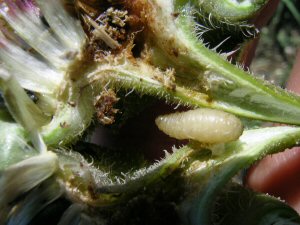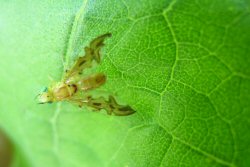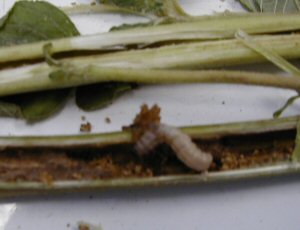Sunflower Maggots
There are three main species that all have larval feeding stages that can cause seed sterility and stalk breakage under high populations. However damage is usually negligible.
Biology
The adult forms of all three sunflower maggots (flies) have wings with a distinct brown or yellowish-brown pattern. The name 'picture-wing fly' has been given to flies of this type. While all three fly species are similar in appearance, they do have distinguishing differences.
Sunflower Receptacle Maggot (Gymnocarena diffusa)
This species is the largest of the three with a body about 10 millimetres (0.4 inches) long and a wing span of approximately 19 millimetres (0.75 inches). The eyes of this species are bright green and the wings have a yellowish-brown and somewhat mottled appearance. Sunflower receptacle maggot larvae attain a length of nearly eight millimetres (0.31 inches) at maturity. The larvae (Figure 1) taper from the front to the rear and are yellowish-white in color.
Adults of the sunflower receptacle maggot emerge in late June to early July after sunflower buds reach five to 10 cm (2 to 4 inches) in diameter. Eggs are laid on the bracts of the developing sunflower heads. Egg laying occurs from mid-July through August. The hatched larvae tunnel into the spongy tissue of the receptacle. Damage to the head is negligible. After 30 days, the mature larvae cut a small emergence hole on the underside of the receptacle and drop into the soil to pupate. Overwintering pupae are found about 19 cm (7.5 inches) deep in the soil by August or early September. Some larvae will pupate in the sunflower head. There is only one generation per year in Manitoba.
Sunflower Maggot (Strauzia longipennis)
Adults (Figure 2) of this species have a wing spread of about 13 millimetres (0.5 inches) and a body 6 millimetres (0.25 inches) long. The wings bear broad dark bands that form a fairly distinct F-shaped mark near the tips. The larvae (Figure 3) of sunflower maggot are creamy white, headless and legless, as are the other two species. They taper slightly at both ends and attain a length of about 7 millimetres (0.28 inches) at maturity.
Sunflower maggots has one generation per year. This insect overwinters as larvae in plant debris in the soil. Pupation and adult emergence are completed in early June. Females lay eggs in stem tissue of young sunflower, and larvae feed in the pith tissue for much of the growing season.
Sunflower Seed Maggot (Neotephritis finalis)
This sunflower maggot is the smallest of the three species with the adult having a body length of about 6 millimetres (0.25 inches) and a wing span of approximately 7 millimetres (0.28 inches). The wings have a brown lace-like appearance. N. finalis larvae attain a length of 4.5 millimetres (0.19 inches) at maturity
Unlike the other two species of sunflower maggots, two complete generations per year of sunflower seed maggots occurs. The first generation pupate in the head; the second generation overwinters in the soil as pupae.
Scouting Techniques
Scouting techniques have not been developed for sunflower maggots because they cause negligible damage.
Economic Thresholds
None established.
Damage
Damage by sunflower receptacle maggots and sunflower seed maggot has been negligible. The magnitude of damage to sunflower seeds by sunflower seed maggot larvae is largely dependent upon the stage of larval and seed development. Seed sterility occurs when newly hatched larvae tunnel into the corolla of young blooms. Observations indicate that a single larva feeding on young flowers will tunnel through 12 ovaries. Mature larvae feeding on older sunflower heads will destroy only one to three seeds.
While infestation levels of sunflower maggots have occasionally reached near 100 per cent, damage from larval feeding is usually light. Part of a commercial sunflower field next to a grassed waterway or other water source sometimes supports a higher than usual infestation. Under these conditions, high larval numbers of eight to 10 per stalk may be found and stalk breakage can occur. Stalk breakage of up to 30 per cent of the plants has been recorded.
Control Tips
Insecticide use has not been warranted for control of sunflower maggots.

Figure 1

Figure 2

Figure 3

